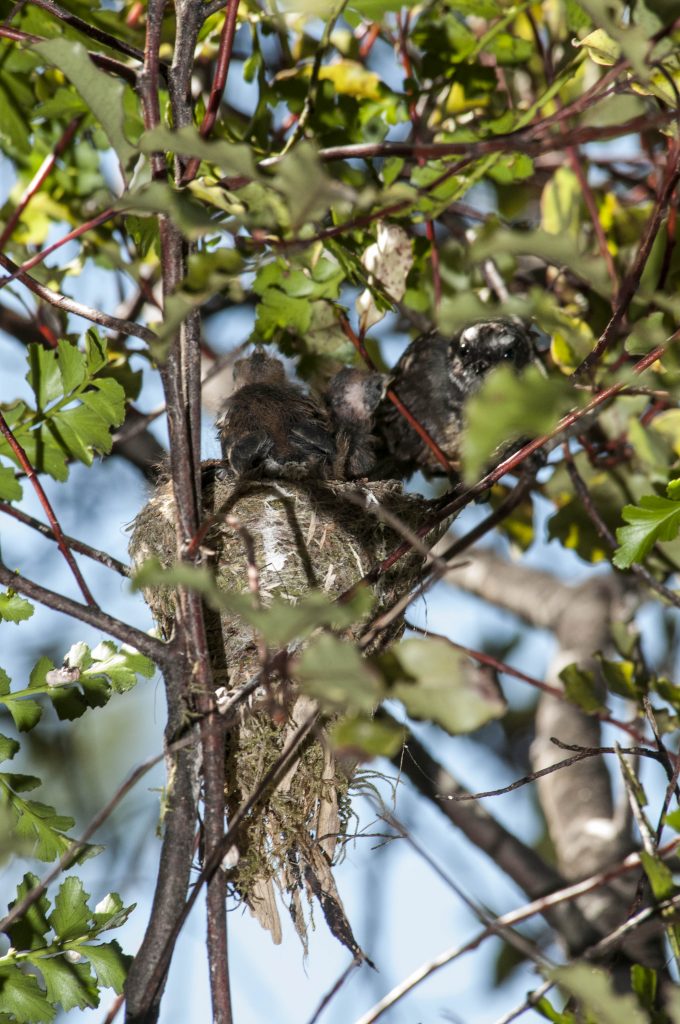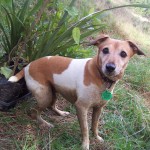Photo of fantail nest found on one of the tracks at the upper end of the valley.

On Monday 5 December, Chris met with Kim Jones, the National Coordinator of the Whitebait Connection programme who is being contracted by Auckland Council to assist Wai Care groups in North Auckland. The stream was tested in two locations. All water quality tests were within safe/healthy levels and a good range of macroinvertebrates were located including some sensitive ones like Free Living Caddisflies, Spotty Stoneflies, and Stony-cased Caddisflies! Amphipods, Isopods, Oligochaete Worms, Rounded Snails, Sandfly Larvae, and Shrimps were also found. More information about those bugs can be found on the Wai Care guide. Shoals of Inanga (native threatened freshwater fish) were found swimming upstream into some nice habitat.
The Whitebait Connection’s umbrella trust; Mountains to Sea Conservation Trust, is holding a Mountains to Sea National Wananga/Conference at the Omaha Marae in April 2017 and are hoping to bring some participants down to the Leigh Harbour Valley stream as part of the training.
View the Wananga Omaha Conference 2017 PDF for further details including registration instructions.
Thanks to Leigh residents all the sedges funded by Auckland Council’s EIF fund have been planted. On 12 November, Richard and his son Troy planted 49 sedges and on 17 November Susan, Neil and Sheryl planted the remaining lot of ~70. All the previous plantings are looking very good. We’ve been so lucky to have had regular rain to keep the ground wet and dunking them in the stream before planting seems to have been good for them.
Jo Evans and Sue Gibbings have been been continuing to check the stoat line and Cam has also been working in the area. At his last visit Cam reported the following tally; 2 ship rats, 2 rabbits, 1 hedgehog and 2 stoats.
It has not been the most successful season for planting and weeding, due to the very heavy rainfall, however, thanks to the input from Leigh residents, Jo and Sue Evans and Richard Taylor; along with our contractor, Cam Rathe, we are gradually making headway.
On 19 October Jo and Sue spent two and a half hours in the valley transporting and planting 48 more sedges in the Harvey patch. The sedges and manuka planted at the last working bee were all looking very good however some of the plants yet to be planted were getting a bit root bound in their PB2s.
Cam was employed for another 8 hours, spraying tradescantia and is doing such a great job keeping up with regrowth. It is so good to have his input and to know he is really dedicated to our mission. Hopefully we can continue to employ him. He also re-baited the stations. The recent tally in the traps was a rat, a large stoat, a hedgehog and a young rabbit.
Niklas Erikson planted another 20 sedges on the Watkinson’s property on Saturday, 22 October and on Sunday, 30 October, Jo, Susan and Richard carried approximately 150 sedges up to the planting site and planted 109 of them. There are still a few plants to go in and we should get these planted within the next 4 weeks.
Our main planting project for Winter 2016 had been to plant 300 sedges and 150 manuka plants that were purchased from Te Hana Nurseries on grant money from the Auckland Council (Rodney Local Grants). Originally scheduled for Sunday 24 July, it had to be postponed a couple of times because of atrocious weather forecasts that would have made transporting the plants the nearly 500m up the slippery streamside track to the planting site (in a clearing in the bush on Harvey’s land) very difficult, if not dangerous.
By late September it was getting urgent to get the plants in the ground and we rescheduled the planting for Sunday 2 Oct. However with another lousy forecast for that day a small group of 5 members decided to get as many of the plants as possible across the stream and on to the track on Saturday morning. Two full ute-loads of plants were driven down to the bottom of the concrete driveway beside the Lee’s brown cottage from where Peter Watkinson ferried them on his 4-wheel-drive mule through his campsite to the stream crossing. We carried all the plants across the stream, stock-piling them beside the track and beginning the transfer to the planting site 250m further upstream.
The next day a workforce of 8 members [Jo & Susan, Arthur & Trish, Neil and Sheryl, John H, Richard T] turned up at 9am in overcast but not unpleasant conditions to transfer more plants and begin planting. Our priority was to first get the manuka planted in the higher, drier parts of the clearing – that had been sprayed earlier to kill rampant Tradescantia. After nearly an hour we started on the sedges, lower down where the ground was wetter.
And that was when the forecast deluge began. We carried on planting with thunder and lightning crashing above and water pouring through the site in rushing rivulets. At least we could see where the ground was wettest and some effort went into channelling the water into more defined streams so that our planting holes did not immediately fill up with water.
By 10.45 we had used up all the plants carried up from the stockpile. The stream had risen to become a fast torrent and we could not cross it to bring up any more so we decided to call it a day. We couldn’t go back the way we had come and had to get out of the valley up through Harvey’s property negotiating the overgrown, slip-damaged track and the waist-high kikuyu paddock.
All participants went home to get dry and warm feeling some satisfaction that they had achieved a lot in a short time. There remain probably about 170 sedges left to bring up and plant and this could be achieved by several small sessions over the next few weeks.
The following is a photograph of a stoat caught in the valley recently. According to our pest control expert, Cam Rathe, it is one of the largest he has ever seen (and he has caught hundreds).

Volunteer members Jo Evans and Sue Gibbings have been regularly checking the stoat line as well as controlling pests on their own property and have caught a number of rats, stoats, weasels and mice. Thanks to their efforts and the efforts of other dedicated members, we are making huge progress in the valley and there is a noticeable increase in bird life.
My son Nik and I attended a workshop at the DoC Warkworth office on Monday, 11 July, to learn about DoC’s new mobile application for recording trapping information called ‘Walk the Line’.
DoC and Auckland Council staff who look after some of the Auckland regional parks were present, along with the local Tfs representative Frankie Hofland, Liz Maire (the Forest Bridge Trust educator) and Kevin & Gill Adshead trustees and founders of the Forest Bridge Trust. Kevin and Gill are an inspiring couple who are farmers of a 3,200 acre seven-generation family farm at Mataia on the Kaipara Harbour. You might have seen them on Country Calendar a few years ago.
The vision of the Forest Bridge trust is to create corridors of native bush and thriving native wildlife from the Kaipara Harbour to the east coast including Pakiri and Leigh by connecting bush remnants, fencing and running a concentrated pest control programme. The Forest Bridge Trust are working closely with schools to eradicate pests via the CatchIT Schools programme. Each student gets a range of pest traps to take home and the results of this pest control programme are recorded.
This project will have positive spin-offs for all those involved in bush restoration in the surrounding areas. It is important to be protecting forest remnants with fencing but our efforts will only be successful when we see an increase in native birdlife and other native fauna. It is exciting that the CatchIT project is being supported by Leigh School and we hope to see the benefits of the children’s pest control activities and to be able to work more closely with the school in the future.
The Leigh Harbour Valley Society is delighted to be included in the publication, Paradise Saved, due for release on Friday, 15 August.
Thanks to Jo Evans who recently carried out 5 hours of weeding and planting along the concrete driveway.
Our next working bee is on Sunday 24 August. We will be meeting at 214 Pakiri Rd, Leigh at 9.30am.
A BBQ lunch will be provided.
Day 1: Glorious, sunny day. However, due to the challenging terrain, the whole day was spent transferring plants down the steep slopes. We were entertained by ‘Flash’, a gorgeous Jack Russell visiting from Christchurch who had 100 times more energy than we did and lived up to his name when it came to chasing and retrieving his tennis ball.

Day 2: Barely able to get out of bed due to aching knees and sore thighs. Approximately 100 plants were left on the slopes to transport down the hill and another 600 were waiting for us on the driveway. Commenced planting at 9.30am. The rain arrived at 10.00 am and became torrential by midday. The slopes were slippery and quite treacherous so it was decided to access the valley from the other side.

Day 3: Another day of planting.
Many thanks to our hard working team of volunteers:-
Trish and Arthur who made two trips to Te Hana Nurseries to collect the plants.
Rupert (and Flash), Niklas, James and Margaret
Margaret Scott, Jo Evans, Sue Gibbings and Carol Banks.
Our next planting day is scheduled for Sunday 1 August.
Hope to see you there.
2010 is the International Year of Biodiversity which celebrates life on Earth and the value of biodiversity for everyone’s lives.